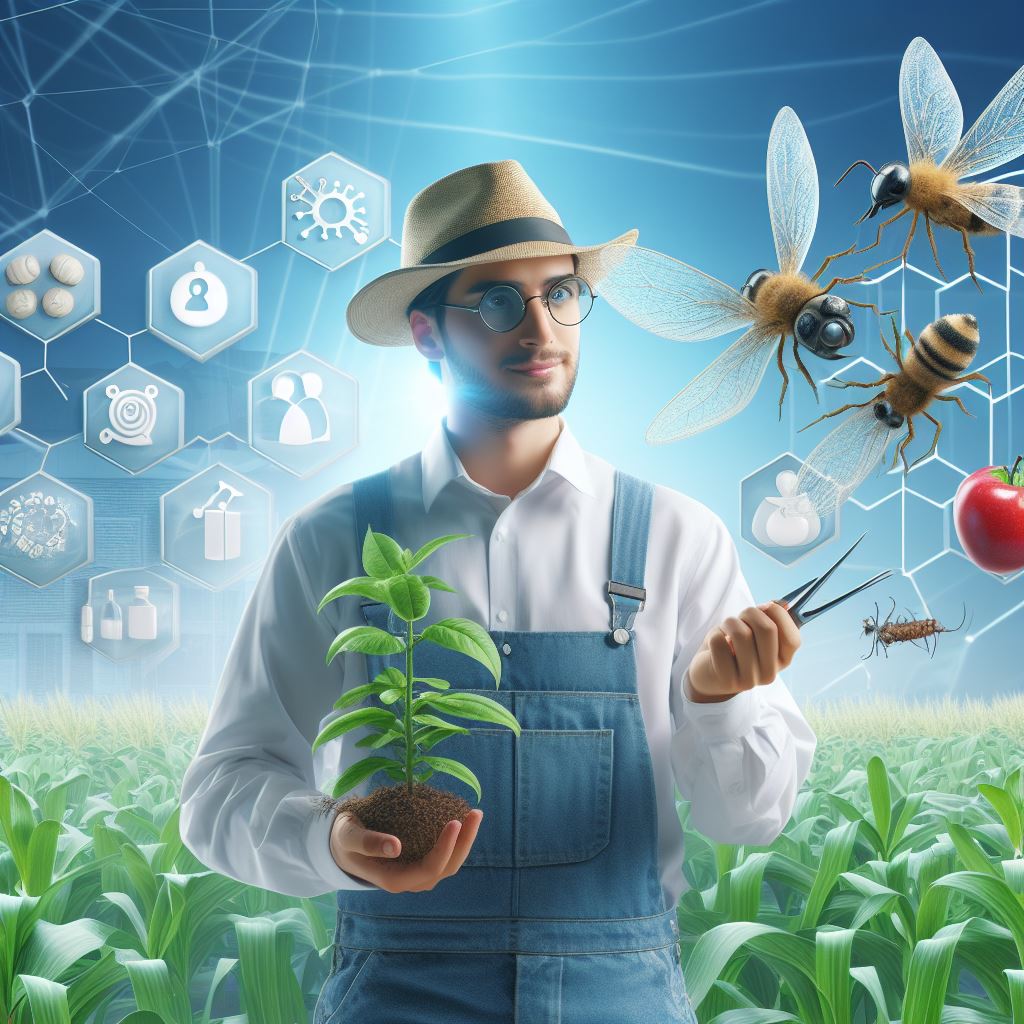Introduction
Cover crops play a crucial role in protecting and enhancing biodiversity in agricultural systems.
Cover crops are plants that are grown to cover the soil between main crop seasons.
They serve multiple purposes, including preventing soil erosion, improving soil fertility, and suppressing weeds.
Biodiversity is essential for the stability and productivity of ecosystems.
It provides resilience against pests, diseases, and climate change, while also offering a myriad of ecosystem services, such as pollination and nutrient cycling.
Cover crops act as guardians of biodiversity by creating habitats and food sources for a diverse range of organisms.
They support beneficial insects, birds, and soil microorganisms, which contribute to pest control and nutrient cycling.
Moreover, cover crops can increase the abundance and diversity of beneficial insects, such as pollinators and natural enemies of pests.
This leads to improved crop pollination and reduced dependence on synthetic pesticides.
In addition, cover crops enhance soil biodiversity by providing a suitable environment for soil microorganisms, earthworms, and other beneficial soil organisms.
These organisms play vital roles in nutrient cycling, soil structure formation, and overall soil health.
By preserving and enhancing biodiversity, cover crops promote ecological balance, reduce the need for chemical inputs, and improve the long-term sustainability of agricultural systems.
In short, cover crops serve as guardians of biodiversity, providing numerous benefits to ecosystems, soil health, and the overall resilience of agricultural systems.
Their presence not only protects the environment but also contributes to the success of farmers and the health of consumers.
Read: Natural Pest Control: A Biodiversity Ally
Transform Your Agribusiness
Unlock your farm's potential with expert advice tailored to your needs. Get actionable steps that drive real results.
Get StartedBenefits of cover crops in promoting biodiversity
- Cover crops play a vital role in enhancing biodiversity by providing a range of benefits.
- They help in reducing the use of chemical fertilizers and pesticides, promoting a healthier ecosystem.
- By holding soil together, cover crops prevent soil erosion, allowing diverse plant and animal life to thrive.
- The presence of cover crops also increases the availability of food and shelter for wildlife.
- The deep-rooting nature of some cover crops improves the soil structure, facilitating the growth of different species.
Enhancing soil health
- Cover crops are known for their ability to improve soil structure, leading to better water infiltration and aeration.
- Through their root systems, cover crops increase organic matter in the soil, providing essential nutrients for other plants.
- The organic matter also acts as a sponge, reducing soil compaction and improving moisture holding capacity.
- Improved soil health helps in the natural control of pests and diseases, reducing the need for chemical interventions.
- Healthier soil also promotes the growth of beneficial soil microorganisms, which contribute to overall ecosystem balance.
The role of healthy soil in supporting diverse plant and animal life
- Healthy soil is the foundation for diverse plant and animal life in any ecosystem.
- It provides a supportive environment for various plant species, fostering a rich and varied plant community.
- A diverse plant community then attracts a wide range of herbivores and other animal species.
- In turn, these herbivores help in pollination, seed dispersal, and maintaining the ecological balance.
- The interdependence between soil health, plant diversity, and animal life highlights the importance of cover crops.
Reducing erosion
- Cover crops act as living armor, protecting the soil from the damaging effects of erosion caused by water and wind.
- Their dense root systems bind the soil particles together, preventing them from being carried away by runoff.
- The aboveground biomass of cover crops also acts as a physical barrier, slowing down water and wind movement.
- Reduced erosion not only preserves precious topsoil but also prevents sedimentation in water bodies.
- Preservation of habitats through erosion control is essential for the survival of various species, maintaining biodiversity.
The role of cover crops in providing habitat for beneficial insects and pollinators
- Insects and pollinators are crucial for maintaining biodiversity and promoting the reproduction of many plant species.
- Cover crops offer a diverse array of flowering plants and shelter, attracting and supporting beneficial insects and pollinators.
- Bees, butterflies, and other pollinators rely on cover crops for nectar and pollen, aiding in pollination.
- Beneficial insects, such as ladybugs and parasitic wasps, help control pests in the ecosystem, reducing the need for pesticides.
- The presence of cover crops creates a habitat mosaic that supports a wide range of beneficial insects and pollinators.
In essence, cover crops play a significant role in promoting biodiversity. Their benefits extend beyond soil health and erosion control.
By providing habitat for beneficial insects and pollinators, cover crops contribute to the overall richness and balance of diverse plant and animal life.
Emphasizing the importance of healthy soil and erosion control, cover crops serve as guardians of biodiversity, ensuring a sustainable and thriving ecosystem.
Read: Permaculture Principles for Biodiversity
Case studies of cover crops benefiting biodiversity
Example 1: Farm in a wildlife corridor
A farm located in or near a wildlife corridor can have a significant impact on biodiversity.
By implementing specific cover crops, farmers can attract and support diverse animal species, ultimately benefiting the overall ecosystem.
One such farm located near a wildlife corridor used cover crops strategically to enhance biodiversity.
The farm in question utilized a combination of legume cover crops such as clovers and vetch, along with grasses like ryegrass and barley.
These cover crops were carefully selected to provide food and shelter for various animal species residing in the adjacent wildlife corridor.
The legume cover crops, renowned for their nitrogen-fixing capabilities, not only enriched the soil fertility but also served as a food source for insects and other herbivores.
These insects, in turn, attracted insectivorous birds, adding a layer of complexity to the farm’s biodiversity.
The positive outcomes for biodiversity were quite evident on this farm.
The diverse cover crop selection created a suitable habitat for an array of animal species, including birds, small mammals, and beneficial insects.
The farm became a refuge for various bird species, including songbirds, raptors, and migratory birds, which found ample food and nesting opportunities within the cover crop fields.
This increased bird population played a crucial role in controlling pests and pollination, contributing to the farm’s overall ecological balance.
Example 2: Cover crops and bird populations
The correlation between cover crops and bird populations
The correlation between cover crops and bird populations has been extensively studied, revealing the positive influence of specific cover crops on attracting and supporting bird species.
How specific cover crops attract bird species
Certain cover crops have proven to be particularly effective in attracting birds to agricultural landscapes.
Research has shown that cover crops such as sunflowers and sorghum can act as strong magnets for bird populations.
Sunflowers, with their vibrant yellow petals and abundant seeds, attract a wide range of bird species, including finches, sparrows, and doves.
Similarly, sorghum provides both food and shelter, attracting bird species such as quails and pheasants.
These cover crops offer a valuable food source for birds, especially during critical periods, such as migration or breeding.
Evidence from studies or research on the benefits observed
Several studies have provided evidence of the benefits observed when implementing cover crops to attract bird populations.
For instance, a research study conducted on agricultural lands found that farmers who incorporated sunflowers as cover crops witnessed a significant increase in bird populations, contributing to pest control and promoting biodiversity.
Another study focused on sorghum cover crops revealed a similar positive impact on bird diversity, with an increase in both resident and migratory bird species.
Showcase Your Farming Business
Publish your professional farming services profile on our blog for a one-time fee of $200 and reach a dedicated audience of farmers and agribusiness owners.
Publish Your ProfileIn fact, cover crops play a vital role as guardians of biodiversity. Through case studies, we have seen how specific cover crops can benefit biodiversity in different ways.
Farms located in or near wildlife corridors can attract and support diverse animal species by utilizing carefully selected cover crops.
Similarly, the correlation between cover crops and bird populations demonstrates that certain cover crops can act as magnets for birds, providing them with food and shelter.
These examples highlight the positive outcomes observed on farms when cover crops are used strategically to enhance biodiversity.
By incorporating cover crops into agricultural practices, we can foster a thriving ecosystem and become stewards of biodiversity.
Read: Conserving Water, Enriching Biodiversity

Challenges and Considerations
Farmers face numerous challenges when incorporating cover crops into their farming practices.
One major challenge is the additional time and labor required to manage cover crops.
Depending on the region, cover crops might need to be planted during specific windows of time.
Another consideration is the potential for cover crops to compete with cash crops for nutrients and water.
Monitoring soil moisture levels is crucial to ensure that cash crops have enough water to grow.
Farmers must also consider the potential trade-offs between cover crops and cash crops.
While cover crops provide numerous benefits, they can also reduce the yield of cash crops
This trade-off between conservation efforts and economic viability can be a delicate balance to strike.
Implementing cover crops might require adjustments in machinery and equipment used in farming.
For example, special equipment may be needed to properly plant cover crop seeds and terminate their growth.
Additionally, farmers must invest in cover crop seeds and have access to reliable sources.
Selecting Appropriate Cover Crops
The selection of appropriate cover crops is crucial to achieve desired biodiversity outcomes.
It is important to choose cover crops based on specific conservation goals.
Some cover crops are better at improving soil health, while others are more effective at reducing erosion.
To enhance pollinator populations, farmers can select cover crops that attract bees and butterflies.
When choosing cover crops, it is also necessary to consider factors such as climate, soil type, and available resources.
Certain cover crops thrive in colder climates, while others are more suitable for warmer regions.
Different soil types might require specific cover crops that can thrive in those particular conditions.
Considering available resources, such as water availability, is also vital when selecting cover crops.
Some cover crops have higher water requirements, which might not be feasible in areas with limited water resources.
In a nutshell, by carefully considering the challenges and trade-offs, farmers can successfully incorporate appropriate cover crops into their farming practices.
Choosing the right cover crops based on specific conservation goals and considering the factors of the ecosystem or region will lead to more fruitful biodiversity outcomes.
Despite the challenges faced by farmers, the benefits of cover crops in protecting biodiversity and promoting sustainable farming cannot be understated.
Read: Wildflower Strips: Nature Farm Aid
Conclusion
Cover crops have proven to be effective guardians of biodiversity.
Recapitulating the benefits, these crops protect the soil, enhance nutrient cycling, and minimize pest outbreaks.
The significance of integrating cover crops into sustainable farming practices cannot be overstated.
By doing so, we can preserve and enhance biodiversity while maintaining the long-term productivity of our land.
Every individual has a role to play in supporting biodiversity through the use of cover crops.
We encourage readers to consider incorporating cover crops in their own gardening practices and to spread awareness about the benefits they offer.
Together, we can foster a healthier and more diverse environment for future generations.




